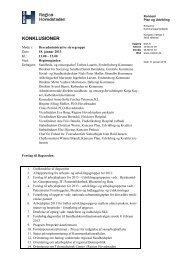Territorial Review Copenhagen - Region Hovedstaden
Territorial Review Copenhagen - Region Hovedstaden
Territorial Review Copenhagen - Region Hovedstaden
Create successful ePaper yourself
Turn your PDF publications into a flip-book with our unique Google optimized e-Paper software.
216<br />
<strong>Copenhagen</strong> Authority, representing one of the many models for<br />
metropolitan governance within the OECD (see Box 3.2).<br />
Box 3.2. Metropolitan governance in OECD countries<br />
The discussion of how to manage metropolitan regions revolves around a<br />
spectrum of models that range from relatively ―heavy‖ to relatively ―light‖ in<br />
terms of the scope of the reform they involve. At the relatively heavy end are<br />
functional models whereby governance structures are reshaped to fit or<br />
approximate to the functional economic area of the metropolitan region.<br />
Examples include the creation of a metropolitan government and the<br />
amalgamation of municipalities. Several metropolitan areas in Canada, for<br />
example, have been subject to amalgamation processes. Among the best-known<br />
metropolitan governments are the Greater London Authority, the Stuttgart<br />
<strong>Region</strong>al Association and the Portland metropolitan district.<br />
In mid-position are a wide range of co-operative arrangements through intermunicipal<br />
joint authorities, most often on a voluntary basis, such as sectoral or<br />
multi-sectoral agencies whose main functions generally include transport, urban<br />
planning or economic development. The governance of US metropolitan regions<br />
is notable for a profusion of regional special districts: one-third of all local<br />
governments in the United States are special districts or school districts. Wellknown<br />
multi-sectoral inter-municipal bodies include for example the Greater<br />
Vancouver <strong>Region</strong>al District and the agglomeration communities and urban<br />
communities in France.<br />
At the light end are informal co-ordination bodies such as platforms,<br />
associations or strategic planning partnerships, often relying on existing<br />
networks of relevant actors without necessarily following the logic of territorial<br />
boundaries. Examples include the association of the Lyon Urban <strong>Region</strong> and the<br />
Ruhr District Association of Local Government Authorities.<br />
Source: OECD (2006), Competitive Cities in the Global Economy, OECD, Paris<br />
Metropolitan co-ordination by the Capital <strong>Region</strong> is a delicate task,<br />
considering the need for the co-operation of municipalities that sometimes<br />
have conflicting interests, and the limited amount of policy instruments at<br />
the region‘s disposal. The task of the regions that comes closest to regional<br />
co-ordination is in regional business development co-ordination through the<br />
<strong>Region</strong>al Growth Forums, which help to articulate regional needs and policy<br />
directions. Business, education, labour organisations and local and regional<br />
governments are represented and help to co-ordinate with municipal<br />
governments in the region. Although the Capital <strong>Region</strong> does not have many

















